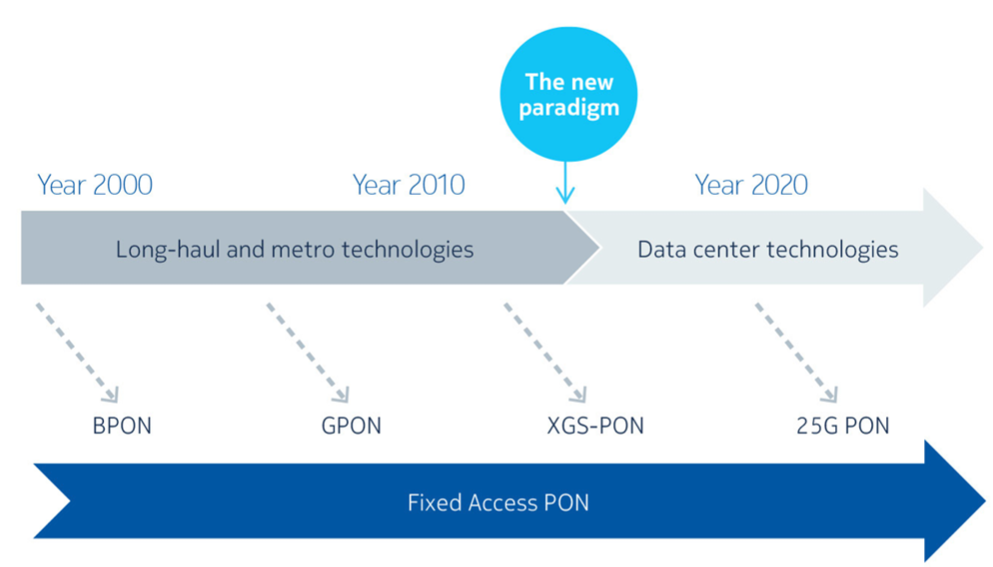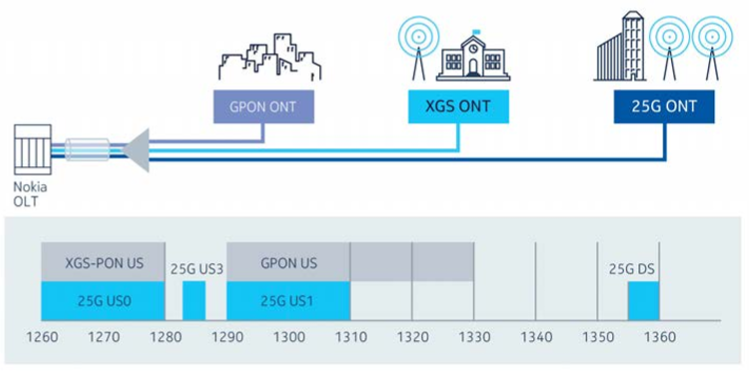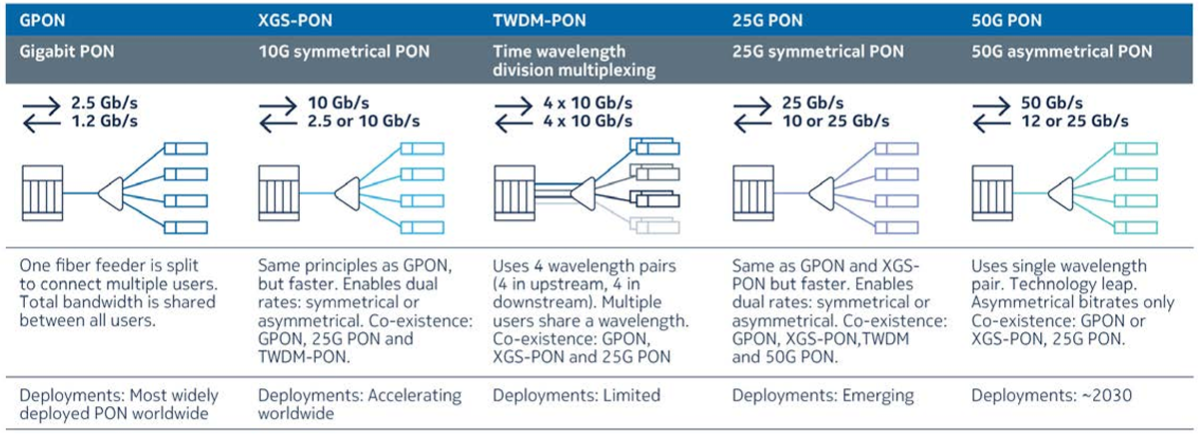
Fiber is the driving force of the broadband connectivity today. It is the biggest and fastest growing fixed access technology with the largest eco-system of players that includes fixed and converged operators, governments, cities, utilities, enterprises, and infrastructure investors. Fiber broadband investment is attractive because it enables a premium customer experience, competitive advantage, the lowest operational costs (OPEX), and the lowest power consumption of any broadband technology, with the additional opportunity of service convergence (residential, enterprise and 5G transport).
One of the greatest attributes of fiber is unlimited bandwidth potential. As technology evolves, the same fiber networks will be able to increase capacity using the same fiber infrastructure, without the need to make updates in the most valuable part of the network: the fiber outside plant.
The increase of capacity is possible by adding new wavelengths (or colors of light), each wavelength carrying data traffic and even working on different transmission rates. New fiber technologies unlock the potential of fiber to be a single infrastructure that underpins the entire telecom ecosystem and connect everything and everyone: consumers, businesses and even 5G cell sites.
Today, fiber networks are based on Gigabit PON (GPON). The next step is XGS-PON which reuses the same outside fiber plant (fiber cables, splitters, and access nodes) to increase bitrates to 10 Gb/s. The industry is already working on further evolutions beyond 10 Gb/s. The next generation of PON technologies are essential to meet ever-growing bandwidth demand and ensure that the fiber networks built out today can be used for decades to come.
This article examines the future PON fiber technologies beyond 10 Gb/s.
The history of PON and the new paradigm
Previous generations of PON technology have derived their origins from long-haul optical technologies. After these technologies were adopted by the metro market, they drove component volumes and maturation further and eventually reached a price point that became viable in a massivescale fixed access deployment. These technologies have had to be adapted for larger power budgets and the burst mode operation used in PON. Nevertheless, the trickle-down process has worked well, spawning EPON, GPON and 10G PON technologies.
The future generations of PON will use a slightly different, but highly efficient path. They will be based on the world of data centers and, specifically, 100G Ethernet technologies with 25 Gb/s channels that are used for intradata center connectivity.
The increased demand for data center capacity, much of it on single-mode fiber, has begun to drive large volumes and reduced costs on 25G components. This is the mature ecosystem that the next generation of PON leverages, and 25 Gb/s will be the baseline for the next steps: 25G, 50G and 100G PON.
Is it possible to just plug these data center components into OLT and ONU transceivers? Of course not. PON applications will require new wavelengths, a higher launch power from transmitters, and greater sensitivity from receivers. However, this is no different from the work that has been done for previous PON generations based on components from long-haul and metro transceivers.

PON evolution depends on the pre-existence of mature optical and electronic technologies. 25G PON leverages mature Data Center optical technologies.
25G PON: the best next step
For an access technology to be successful, a few significant requirements need to be fulfilled. The first is cost efficiency, which includes CAPEX and cost of introduction, etc. In massive access networks deployments, where millions need to be connected, cost-efficiency is key. There are examples of technologies that have a very attractive value proposition but, because of complexity and a very high cost, they did not become widely adopted. Next, there must be well-defined, viable use cases in the near- and mid-term for the technology. 25G PON fulfils these conditions.
Cost efficiency
25G will be the most cost-effective evolutionary step for the next decade. It leverages mature and massively deployed data center technologies. It is a simple technology which does not require advanced digital signal processing (DSP), amplifiers or tunable lasers. 25G PON is likely to be the last step in the evolution that will be a straight evolution from 10G PON: steps beyond 25G will be a technology leap and require advanced DSP and optical amplifiers or even coherent, all of which will take years to mature.
Use cases
The massive capacity of 25G PON will enable unified services—connecting everyone and everything over a single highperformance network. Operators are already seeing the demand for speeds beyond 10 Gb/s to:
- Connect enterprises with true 10G (current marketplace) and >10G speeds for bandwidth-demanding, latency-sensitive applications, and enable greater ARPU vs. residential services.
- Provide mobile transport (i.e., X-haul) for the high volume of traffic from densely deployed 5G antennas.
- Wholesale providers need big pipes to meet the demand of all their tenants and applications. 25G PON is ideally suited to network slicing, which can be used to maximize network utilization and differentiate quality of service (QoS) for each tenant or service.
- Enable next-generation services and capabilities like remote surgery, massive scale Virtual Reality, real-time digital twins, etc. Although the residential market is not yet a strong driver for 25G PON, some operators will consider it for disruptive true 10G services or for cost optimization with high split ratios in greenfield environments.
Huge capacity
25G PON is 10x faster than GPON and 2.5x faster than XGS-PON. The Ethernet market has found that a step increase in speed by a factor of 2-2.5x delivers the best commercial results. The 25G step has been adopted by IEEE (25G EPON), data centers, WDM, G.metro and 25GS-PON MSA. It is driven by concrete demand for enterprise services and 5G transport and will be able to meet residential demands when the time comes. To illustrate: today, 1 Gigabit is a product for premium connectivity in many markets, and 25G (when overheads are accounted for) is 20x faster. That should be enough bandwidth for at least the next decade.
Simple introduction

25G PON wavelength plan ensures triple co-existence (GPON, XGS-PON and 25G PON)
Co-existence is a major requirement for ensuring graceful migration and avoiding complicated (and costly) operations. Network upgrades don’t happen overnight, they are done gradually, so old and new technologies will need to co-exist for many years. By the time upgrades to >10G are needed, most networks will have both GPON and XGS-PON in the field.
One of the great attributes of 25G PON is that it can seamlessly co-exist with both GPON and XGS-PON, so there can be three generations of PON on the same fiber infrastructure, which enables operators to use the right technology and speeds for each service. There are no forced migrations, no restrictions, and no overlay deployments.
Availability
Operators are already seeing the need for capacity beyond 10 Gb/s and 25G PON is available today. Operators will be able to react quickly when needed and protect their business. Waiting for a new technology—and losing opportunities in the meantime—is not an option.
This is why 25G PON is so important. It is available today, has huge capacity and is very easy to introduce. 25G PON was already introduced in a live network.
25G PON implementation
The guiding principle of 25G PON is to deliver 2.5x more bandwidth at <2.5 higher cost. The strategy to lower the incremental cost is composed of the following elements:
- O-band wavelengths. Dispersion increases with higher bit rates. 25G PON downstream and upstream wavelengths need to be in the O-band to avoid large penalties or the need for dispersion compensation.
- Transmission. While leveraging data center technologies, 25G PON does not require all the functionalities needed in data centers. Instead of higher-level, costly modulation schemes like PAM4, it can use simple non-return-to-zero (NRZ) transmission.
- Optical amplification. 25 Gb/s has about a 5 dB power penalty compared to 10 Gb/s. To achieve a 29 dB (PR30 EPON, N1 class ITU-T PON) loss budget, and to avoid the cost of optical amplification, those 5 dBs need to come from a combination of higher launch power, improved receiver sensitivity and stronger FEC. This will be possible, but with little margin to spare.
- Dual-rate transmission. 25G PON supports both symmetrical (25/25) and asymmetrical (25/10) bitrates. This enables the use of lower cost 25G/10G ONTs where symmetry is not needed.
The 25G-PON standard specifies 1358 nm wavelength in downstream and three options for upstream:
- Option 1: 1300 nm (subset of GPON) for co existence with XGS-PON.
- Option 2: 1270 nm (same as XGS-PON) for co existence with GPON.
- Option 3: 1286 nm to support triple co-existence of 25G PON, XGS-PON and GPON.
This choice of wavelength plan ensures a smooth evolution path in any network.
The path to 50G PON
 The standardization work on 50G PON G.hsp (Higher Speed PON) is already under way and Nokia is one of the main contributors to the ITU-T standardization work. The evolution to 50G PON is a long-term evolution, and it is more of a quantum leap than an evolution. Running at such high speeds has several engineering challenges. Tweaks to address these challenges increase the complexity and cost, and time to mature.
The standardization work on 50G PON G.hsp (Higher Speed PON) is already under way and Nokia is one of the main contributors to the ITU-T standardization work. The evolution to 50G PON is a long-term evolution, and it is more of a quantum leap than an evolution. Running at such high speeds has several engineering challenges. Tweaks to address these challenges increase the complexity and cost, and time to mature.
50G PON will be able to use some 25G components but not everything. It will need new, more costly 50 Gb/s transmitters and amplifiers (EML+SOA). This is because when a 25 Gb/s transmitter tries to transmit at 50 Gb/s, the signal is distorted. To compensate, 25G transmitters will need to be used in combination with optical amplifiers. The alternative is to use 50G transmitters. In both cases, the cost is higher.
50G PON can leverage 25G optical components in receivers, but it will need advanced DSP to be able to achieve 50 Gb/s bitrates with 25 Gb/s optics. This adds significant cost. In fact, that will be the case with all technologies beyond 25G PON. To bring the cost down, DSP must be integrated in SoC (system on chip) and reach high volumes, which will take time. It is expected that 50G will not take off in the next 7-8 years. This also means there will not be mass volumes before 2030 to drive down the cost. None of this is an issue for 25G PON.
50G PON will require optical amplifiers for all loss budgets. For higher speeds, there is a higher power penalty at the receiver so, to compensate, 50G PON needs to launch at a higher power at the transmitter.
Although Nokia Bell Labs has had a 50G PON demo for some time, and early industry prototypes are being available, it does not mean that 50G will be deployable soon. There is a need for further research work to optimize the technology. For example, the practicality of high loss budgets (>29 dB) is still to be determined. The symmetrical bandwidth is still under evaluation (note that the 50G standardization deferred the specification for 50G in upstream because of its complexity and has standardized 12.5Gb/s and 25Gb/s in upstream).
Another challenge of 50G PON is the co-existence with other technologies. The current specification enables co-existence with GPON or XGS-PON but not both at the same time. Consequently, operators who want to introduce 50G PON in their networks must either decommission their GPON network first and move all customers to XGS-PON, or skip the XGS-PON step and upgrade GPON to 50G PON directly. This clearly complicates the evolution path, which is not the case with 25G PON, as it can co-exist with GPON, XGS-PON and even 50G PON simultaneously on the same PON.

Overview of TDM PON technologies
The futuristic 100G PON and beyond
Nokia Bell Labs recently showed the industry’s first 100G PON demo. Bell Labs leveraged the same base technology that is needed for 50G PON using advanced DSP techniques that are not yet commercially available. Once there is a baseline ecosystem for 50G PON, the step to 100G PON will follow quickly.
The Bell Labs demo also demonstrated Flexible Data Rates, which is an industry-first in PON networks. Flexible rate transmission groups ONUs that exhibit similar physical network characteristics (e.g., located at around the same distance from the OLT, with similar loss or dispersion). ONU groups benefit from dedicated, optimized performance e.g., more efficient data transmission, lower latency, and lower power consumption. Note that Flexible Data Rates is not a feature that is directly linked to 100G PON; it could be implemented for any PON technology.
The higher speed of 100G PON brings a power penalty at the receiver. In 50G PON, this problem can be solved by a higher launch power at the transmitter. However, for 100G PON this is not a practical approach, and more advanced solution for the receiver must be found.
To fulfill a 29 dB and 32 dB loss budget, 100G TDMPON will probably require a coherent receiver. For symmetrical 100G, a coherent burst mode receiver will be required, and this is an active area of research. There are at least three possible scenarios that could lead to a practical 100G coherent PON in the second half of the next decade:
- Leverage traditional long-haul and metro 100G coherent, if the costs erode to PON price points (not likely)
- Leverage data centers coherent (likely in the mid-2020s), with performance-cost trade off, which would be possible because shorter distances are used.
- Optimize coherent architecture specifically for PON.
Regardless, the PON industry has a few years before needing to make technology decisions about 100G PON.
Once coherent technology proves-in for TDM PON, the sky is the limit. 400G coherent is already deployed today in core, metro and lately DCI networks, and commercial systems supporting more than 400G are emerging.
 Conclusion
Conclusion
It is important to keep pushing the boundaries of PON technology and make sure the investments in fiber networks made today will be usable for many years to come to meet the inevitable growth in demand for faster, more responsive, and immersive internet services.
The industry is already embracing 25G PON and the research work on 50G and 100G PON is ongoing. Nokia is leading the industry, with the first 25G PON commercial solution that has been deployed in a live network. We are one of the main contributors to the ITU-T 50G PON standard. In early 2021, we demonstrated the industry’s first 100G PON prototype.
However, 50G PON and 100G PON are still far from being deployable. They require more research, development of a new generation of lasers, optical amplifiers and DSPs, and further optimization to reach maturity and an acceptable cost point. These advances in technology will ensure the evolution of fiber networks and demonstrate the superiority of fiber to serve as a unified infrastructure to connect everything, everywhere.
This article was kindly contributed by Nokia
